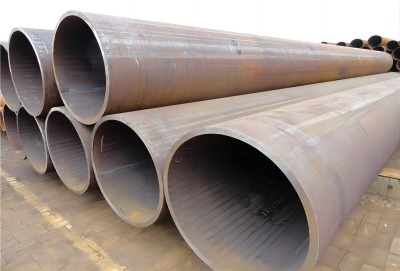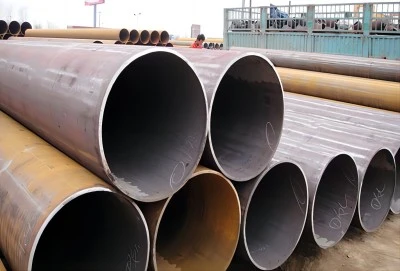When it comes to selecting the right pipe for your project, understanding the differences between DSAW (Double Submerged Arc Welded) and ERW (Electric Resistance Welded) pipes is crucial. Both types of pipes have their unique characteristics, strengths, and ideal applications. In this comprehensive guide, we'll explore the structural differences, compare their strength and performance, and provide application-specific recommendations to help you make an informed decision.
|
|
|
Structural Differences between DSAW and ERW Pipes
DSAW and ERW pipes are both widely used in various industries, but they differ significantly in their manufacturing processes and resultant structures.
DSAW pipes, also known as LSAW (Longitudinal Submerged Arc Welded) pipes, are manufactured using a submerged arc welding process. This method involves joining two curved steel plates along their longitudinal edges. The welding is performed on both the inside and outside of the pipe, resulting in a double-welded seam. This process allows for the production of pipes with larger diameters and thicker walls, typically ranging from 16 inches to 100 inches in diameter and up to 2 inches in wall thickness.
On the other hand, ERW pipes are produced using electric resistance welding. In this process, a flat steel strip is rolled into a cylindrical shape, and the edges are joined using high-frequency electric current. The welding occurs along the entire length of the pipe in a single pass. ERW pipes are generally smaller in diameter, typically ranging from 2 inches to 24 inches, with wall thicknesses up to 0.5 inches.
The key structural difference lies in the welding method and the resulting seam. DSAW pipes have a thicker, more robust weld seam due to the double welding process, while ERW pipes have a single, thinner weld seam. This structural difference significantly impacts the pipes' strength, durability, and suitability for different applications.
Strength and Performance Comparison: DSAW vs ERW
When comparing the strength and performance of DSAW and ERW pipes, several factors come into play, including tensile strength, pressure resistance, and overall durability.
DSAW pipes generally exhibit superior strength and performance characteristics due to their manufacturing process. The double-welded seam provides enhanced structural integrity, making these pipes more resistant to high internal pressures and external loads. This increased strength allows these pipes to maintain their shape and resist deformation under stress, making them ideal for high-pressure applications and harsh environments.
The tensile strength of DSAW pipes is typically higher than that of ERW pipes, especially in larger diameters. This higher tensile strength translates to better resistance to longitudinal stresses, which is particularly important in applications involving significant temperature fluctuations or seismic activity.
ERW pipes, while generally not as strong as DSAW pipes, still offer reliable performance for many applications. Their strength-to-weight ratio is often favorable, making them a cost-effective choice for low to medium-pressure systems. ERW pipes also tend to have a smoother internal surface, which can be advantageous in applications where flow efficiency is crucial.
In terms of fatigue resistance, DSAW pipes typically outperform ERW pipes. The double-welded seam of DSAW pipes distributes stress more evenly, reducing the likelihood of fatigue-related failures over time. This characteristic makes DSAW pipes particularly suitable for applications involving cyclic loading or frequent pressure changes.
It's important to note that advancements in ERW manufacturing technology have significantly improved the quality and performance of these pipes in recent years. Modern ERW pipes can now meet stringent quality standards and perform reliably in many applications that were previously considered suitable only for DSAW pipes.
Application-Specific Recommendations: When to Use DSAW or ERW?
Choosing between DSAW and ERW pipes depends on various factors, including the specific requirements of your project, operating conditions, and budget considerations. Here are some application-specific recommendations to guide your decision:
When to Choose DSAW Pipes:
1. High-Pressure Applications: DSAW pipes are the preferred choice for high-pressure systems, such as long-distance oil and gas transmission pipelines. Their superior strength and pressure resistance make them ideal for these demanding applications.
2. Large Diameter Requirements: If your project requires pipes with diameters exceeding 24 inches, DSAW pipes are typically the go-to option. They can be manufactured in much larger diameters than ERW pipes.
3. Offshore and Subsea Projects: The enhanced durability and corrosion resistance make them suitable for challenging offshore and subsea environments where pipe integrity is critical.
4. Extreme Temperature Conditions: Perform well in both extremely high and low-temperature environments, making them suitable for applications in arctic regions or high-temperature industrial processes.
5. Critical Infrastructure: For projects where pipe failure could have severe consequences, such as in nuclear power plants or major urban water supply systems, the enhanced reliability of DSAW pipes is often preferred.
When to Choose ERW Pipes:
1. Low to Medium Pressure Systems: ERW pipes are well-suited for applications with low to medium operating pressures, such as water distribution networks, fire protection systems, and HVAC piping.
2. Smaller Diameter Requirements: For projects requiring pipes with diameters up to 24 inches, ERW pipes offer a cost-effective and reliable solution.
3. Construction and Structural Applications: ERW pipes are commonly used in construction for structural support, such as in scaffolding, fencing, and light poles.
4. Fluid Transportation: The smooth internal surface of ERW pipes makes them an excellent choice for transporting fluids where flow efficiency is important, such as in industrial process piping or irrigation systems.
5. Cost-Sensitive Projects: When budget constraints are a significant factor and the application doesn't require the high-performance characteristics of DSAW pipes, ERW pipes can provide a more economical solution without compromising safety or reliability.
It's important to note that these recommendations are general guidelines. The final decision should always be based on a thorough analysis of your specific project requirements, relevant industry standards, and consultation with engineering experts.
Contact Information
For projects requiring high-quality, large-diameter pipes capable of withstanding extreme conditions, DSAW pipes are often the preferred choice. Their double-welded seam provides superior strength and durability, making them ideal for demanding applications in the oil and gas industry, offshore projects, and critical infrastructure.
On the other hand, ERW pipes offer an excellent balance of performance and cost-effectiveness for a wide range of applications. Their smooth internal surface and reliable performance in low to medium pressure systems make them a popular choice in construction, water distribution, and various industrial processes.
Ultimately, the choice between DSAW and ERW pipes should be based on a careful evaluation of your project's specific requirements, including operating pressure, diameter needs, environmental conditions, and budget constraints. Consulting with experienced engineers and reputable manufacturers can provide valuable insights to help you make the best decision for your project.
If you're looking for high-quality DSAW or ERW pipes for your next project, consider Longma Group. As one of China's leading ERW/LSAW steel pipe manufacturers since 2003, Longma Group specializes in the production of large-diameter, thick-walled, double-sided, sub-arc-seam welding steel pipes, including LSAW (Longitudinal Submerged Arc Welded) and ERW steel pipes. With an annual output exceeding 1,000,000 tons by the end of 2023, Longma Group has the capacity and expertise to meet your steel pipe needs. For more information or to discuss your project requirements, please contact us at info@longma-group.com.














